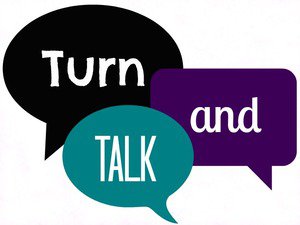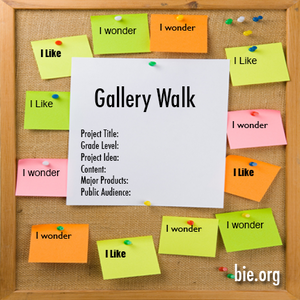Four Steps to Structured Student Conversations
Guest post by Stacy Sniegowski, EdConnective Instructional Coach
Four Steps to Structured Student Conversations: aka component 3b of Charlotte Danielson’s Framework for Teaching.
If you are new to the teaching career, these next few weeks before Thanksgiving might be a tough time. The “honeymoon” period is over. Late nights are filled with school events, endless stacks of work to grade, and projects to plan. The exhaustion is starting to soak in. You’re starting to annoy your friends by always talking about “your kids,” and your family hopes that they’ll get to see you before Thanksgiving.
On the up side, you know your students and communicate with their parents regularly. You maintain structure in your classroom and most of the students understand and follow rules because you are very consistent. Your classroom is a place where students talk when called on, listen, and follow your directions. Still, you as the teacher are the one who is drained at the end of every day, not the students. If you want to survive, then it’s time to let your students do some more of the work for you.
If you are looking for ways to engage all of your learners, while also supporting the needs of diverse learners, then it’s time to get them to start talking. Here’s my four-step method to getting students into the roles of partner, presenter, teammate, and teacher.
1. Start Small and Short. (Click to Tweet)
Many teachers, myself included, fear “letting go” and allowing students to talk. I’ve often heard my peers say, “I just don’t trust my students to work in groups.” The fact is, our directions for discussions matter. Protocols and games that are quick and timed build practice for student accountability during classroom conversations. These strategies work best with vocabulary, prior knowledge, and open-ended questions where students can think and work quickly. Turn and Talks, Dance to Find a Partner, and “Speed  Interviews” (think speed dating, where students stand in a line and shift every one or two minutes so they talk with five to 10 others in 10 minutes) all involve two students exchanging information with each other. In the beginning of implementation, posting a timer on the projector or using a big teacher-timer helps students self-regulate. For students who have a tough time listening, offer strategies for keeping quiet for 10 seconds to one minute, depending on the topic. Phrases like, “Partner A: lips zipped!” or “Partner A: silent listener, ready?” remind students of their role. The short amount of time keeps students focused on the task at hand (i.e. What do you think the word “equation” means?), while creating a positive classroom energy. As the teacher, it’s important to have a consistent method for switching speakers and to never lose track of the time. Use cold calling after the structured talk so that students learn you are holding them accountable for talking on topic. Ask students to share what their partners said to lower the pressure and encourage active listening.
Interviews” (think speed dating, where students stand in a line and shift every one or two minutes so they talk with five to 10 others in 10 minutes) all involve two students exchanging information with each other. In the beginning of implementation, posting a timer on the projector or using a big teacher-timer helps students self-regulate. For students who have a tough time listening, offer strategies for keeping quiet for 10 seconds to one minute, depending on the topic. Phrases like, “Partner A: lips zipped!” or “Partner A: silent listener, ready?” remind students of their role. The short amount of time keeps students focused on the task at hand (i.e. What do you think the word “equation” means?), while creating a positive classroom energy. As the teacher, it’s important to have a consistent method for switching speakers and to never lose track of the time. Use cold calling after the structured talk so that students learn you are holding them accountable for talking on topic. Ask students to share what their partners said to lower the pressure and encourage active listening.
2. Practice and Perfect with Resources, Roles, and Rubrics. (Click to Tweet)
Once students are accustomed to learning from talking with peers for short periods of time, the length of the conversations and number of students should increase along with the structures to support the discussions. Graphic organizers, scripted question stems, GoogleDocs, and note-taking guides encourage students to stay on task and ask the right questions. These tools also reinforce learning when students translate their conversation into writing. When students work on more complex tasks, like creating an algebraic word problem, or constructing three arguments for and against a social cause, they need guidance for distributing the work. In addition to titles, be sure to include descriptions and responsibilities for each of the roles. Provide students with feedback when you notice they are or are not following their roles. Finally, if their work together is regular or sustained over time for a lab or project, allow them to evaluate each other at the end of their work, and make sure they know this will happen before they begin. If you’re freaking out that this sound like a lot of work—stop now! There is no need to reinvent the wheel. Get on the Internet and search for “group roles” and “group rubrics.” When you find something close to what your students need, modify so that it matches your classroom culture and norms. You can start by checking out some of the resources I’ve shared on my website.
3. Keep Kids Communicating. (Click to Tweet)
Once your students have learned that you maintain a classroom environment where student voice is the  norm, the variety of strategies that you implement can increase and evolve to meet the needs of your students. I taught block periods in summer programs where classes ranged from 75 to 120 minutes, so integrating movement into instruction was essential to managing my students’ behavior and engagement. By integrating protocols like Gallery Walks, “stand up” partners, learning stations, concept sorts, and Four Corners, students participate in timed and focused discussions with controlled movement. Teachers can integrate other instructional technology supports like Class Dojo or the low-tech version, popsicle sticks with students’ names, to assess the quality of discussions at stations or corners. Since these activities often push students to think at higher levels, like a Gallery Walk where multimedia resources are posted around the room for students to gather evidence for a claim related to the novel they are reading or a current or historical event, the time is extended upwards of fifteen minutes. It’s important to create a sense of urgency to maintain student focus. Many teachers have found that using odd times, like eight or 11 minutes and posting the time on a large timer works to maintain student productivity.
norm, the variety of strategies that you implement can increase and evolve to meet the needs of your students. I taught block periods in summer programs where classes ranged from 75 to 120 minutes, so integrating movement into instruction was essential to managing my students’ behavior and engagement. By integrating protocols like Gallery Walks, “stand up” partners, learning stations, concept sorts, and Four Corners, students participate in timed and focused discussions with controlled movement. Teachers can integrate other instructional technology supports like Class Dojo or the low-tech version, popsicle sticks with students’ names, to assess the quality of discussions at stations or corners. Since these activities often push students to think at higher levels, like a Gallery Walk where multimedia resources are posted around the room for students to gather evidence for a claim related to the novel they are reading or a current or historical event, the time is extended upwards of fifteen minutes. It’s important to create a sense of urgency to maintain student focus. Many teachers have found that using odd times, like eight or 11 minutes and posting the time on a large timer works to maintain student productivity.
4. Every Student, Every Day. (Click to Tweet)
As a teacher, I see my role as not just a facilitator of learning, but an assessor of understanding. Over the past nine years, I have learned that the more I broaden my methods for how I collect assessment data from my students, the better they perform and the more I know the needs of individual students. Strategies like verbal exit tickets and one-on-one conferencing reinforce the classroom culture for speaking about learning while allowing me to gauge what my students know beyond what they were able to write on paper or on a computer. The Common Core State Standards are holding students accountable for developing speaking and listening skills. To me, this means it is even more essential that teachers of all content areas provide students with opportunities to ask and answer each other’s questions, prepare for conversations, and discuss texts. The third Standard for Mathematical Practice, states that students should be able to critique the reasoning of others, and math talks require students to listen, paraphrase, and question the thinking of their peers. For some students, these daily safe and structured opportunities to talk and be heard are the only ones in their day. To support their development as learners and 21st century communicators who can collaborate while creating products and thinking critically, teachers must provide daily opportunities for students to talk about what they are learning and practice academic conversations.
My success with student conversations was not in isolation. In addition to observing colleagues who were able to successfully integrate complex strategies like Socratic Seminar and jigsaws, I also used Teaching Channel and attended professional development sessions focused on interdependent group work and gamification of the classroom. Find your passions connected to structured student talk and do your own action research around what works best for your students. What works may vary for times of the day, content, and level of complexity. Use Twitter and your professional learning network to develop your craft and master the art and science of students speaking to solidify knowledge and think critically. Please share your successes with me @cornzippers and @edconnective. I can also help you, one-on-one, with structured student conversations and other student outcomes as your EdConnective instructional coach.
Stacy’s Prologue to “Four Steps to Structured Student Conversations”
 When I was a first year teacher at a charter school in Chicago’s Washington Park neighborhood, my ninth grade students talked “all the time.” Their discourse, while sometimes on point, was often off topic because I had not yet succeeded in creating the classroom environment mentioned above. However, after nine years in the classroom—five as a mentor to teachers mostly new to the career, and five years as a teacher of science, math, engineering, and French—I now know that students need to talk to understand. Even though I am an auditory learner who has to talk and ask questions to understand, I was clueless as to how to do this with students. I let them “work with an elbow partner,” called on every single raised hand, required all students to share their “thinking” on the board, and braved eight labs and one project.
When I was a first year teacher at a charter school in Chicago’s Washington Park neighborhood, my ninth grade students talked “all the time.” Their discourse, while sometimes on point, was often off topic because I had not yet succeeded in creating the classroom environment mentioned above. However, after nine years in the classroom—five as a mentor to teachers mostly new to the career, and five years as a teacher of science, math, engineering, and French—I now know that students need to talk to understand. Even though I am an auditory learner who has to talk and ask questions to understand, I was clueless as to how to do this with students. I let them “work with an elbow partner,” called on every single raised hand, required all students to share their “thinking” on the board, and braved eight labs and one project.
At the end of my first year, I reflected on the best and worst earth science lessons of the year. I quickly realized that those most successful days were those lessons that involved labs and projects. Most of the worst days were when I planned for my students to take notes, as I, the professional with a college degree, explained important information to them. I learned that anchoring concepts with projects or real-world situations was important to engage students.
Like most teachers, new teachers, I became a professional learner.
The labs and projects were some of the few “structured talk” opportunities I gave my students. These lessons were the only times I planned for students to work together on a task where they were allowed to have collaborative conversations focused around academic language. They were also the days in class where I heard what every student was thinking, not just the ones quick to raise hands. At the end of one of the trainings I took to be a New Teacher Center mentor, I was able to synthesize the multiple teaching strategies I had learned to support English language learners, students with diverse academic needs, and students with social/emotional needs.
Follow EdWeek Market Brief on Twitter @EdMarketBrief or connect with us on LinkedIn.
See also:


chloroquinr https://chloroquineorigin.com/# hcqs 400